
Catocala is a generally Holarctic genus of moths in the family Erebidae. The genus was erected by Franz von Paula Schrank in 1802. The moths are commonly known as underwing moths or simply underwings. These terms are sometimes used for a few related moths, but usually – especially when used in plural, not as part of a species name – they are used to refer to Catocala only.

Catocala fraxini, the blue underwing or Clifden nonpareil, is a moth of the family Erebidae. The species was first described by Carl Linnaeus in his 1758 10th edition of Systema Naturae.

Catocala fulminea, the yellow bands underwing, is a moth of the family Erebidae. The species was first described by Giovanni Antonio Scopoli in his 1763 Entomologia Carniolica. It is found in central and southern Europe, east Asia and Siberia. The xarippe lineage has been proposed to be a distinct and valid species in its own right, instead of being only subspecifically distinct.

Drasteria is a genus of moths in the family Erebidae.

Catocala ilia, the Ilia underwing, beloved underwing or wife underwing, is a moth of the family Erebidae. The species was first described by Pieter Cramer in 1776. It can be found in the eastern part of the United States as well as southern Canada. Subspecies Catocala ilia zoe can be found in California and Arizona.

Catocala meskei, or Meske's underwing, is a moth of the family Erebidae. The species was first described by Augustus Radcliffe Grote in 1873. It is found in North America from Maine and Quebec west to southern Alberta and Montana, south to South Carolina in the east and at least Montana in the west.

Catocala junctura, the joined underwing or Stretch's underwing, is a moth in the family Erebidae. The species was first described by Francis Walker in 1858. It is found throughout temperate North America, ranging from New York and Pennsylvania west to Montana, Colorado, Oklahoma, Arizona, and into Texas, and north to southern Illinois, extreme southern Alberta and Saskatchewan; it has also been recorded west of the Rocky Mountains from California and south-eastern British Columbia. It is typically found near water, where the food plants of its caterpillar larvae grow plentifully.
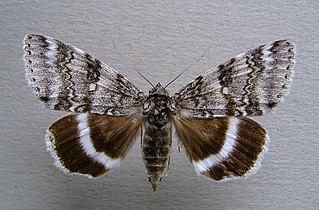
Catocala relicta, the white underwing or relict, is a moth of the family Erebidae. The species was first described by Francis Walker in 1858. It lives in southern Canada, from Newfoundland to Vancouver Island, south to Missouri, and Arizona.
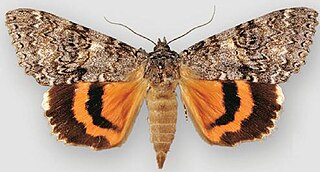
Catocala unijuga, the once-married underwing, is a moth of the family Erebidae. The species was first described by Francis Walker in 1858. It is found in North America from Newfoundland west to south central British Columbia, south to Kentucky and Missouri in the east, Colorado and Utah in the west.
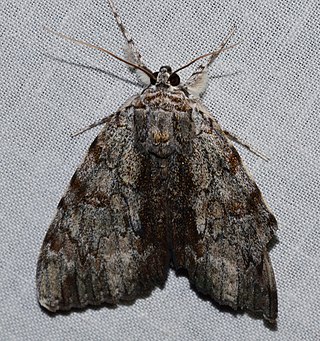
Catocala insolabilis, the inconsolable underwing, is a moth of the family Erebidae. The species was first described by Achille Guenée in 1852. It is found in North America from Ontario through Maine and Connecticut south to Florida, west through Arkansas to Texas and Oklahoma and north to South Dakota.

Catocala maestosa, commonly known as the sad underwing, is a species of moth in the family Erebidae. The species was first described by George Duryea Hulst in 1884. It is found in the United States from New York south to Florida and Alabama, west to Texas and eastern Oklahoma and north to Illinois, Indiana and Minnesota.

Catocala muliercula, the little wife underwing, is a moth of the family Erebidae. The species was first described by Achille Guenée in 1852. It is found in the US from Massachusetts and Connecticut south to Florida and west to Texas and New Mexico.
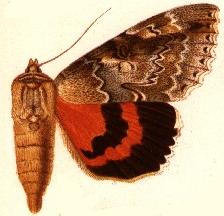
Catocala marmorata, the marbled underwing, is a moth of the family Erebidae. The species was first described by William Henry Edwards in 1864. It is found in the United States from Vermont to South Carolina and west to Indiana and Illinois.

Catocala grynea, the woody underwing, is a moth of the family Erebidae. The species was first described by Pieter Cramer in 1780. It is found in North America from Ontario and Quebec through Maine and Connecticut, south to Florida, west to Texas and north through Iowa to Wisconsin and Minnesota.
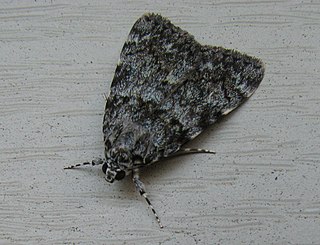
Catocala lineella, the lineella underwing, little lined underwing or steely underwing, is a moth of the family Erebidae. The species was first described by Augustus Radcliffe Grote in 1872. It is found in North America from Ontario and Quebec south to Florida west to Texas and north to Ohio.
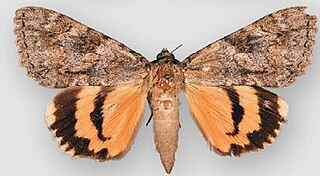
Catocala jessica, the Jessica underwing, is a moth of the family Erebidae. The species was first described by Henry Edwards in 1877. It was described in the United States from Arizona through Colorado to Illinois and California.

Catocala mira, the wonderful underwing, is a moth of the family Erebidae. The species was first described by Augustus Radcliffe Grote in 1876. It is found in North America from Manitoba through southern Ontario and Quebec through New Hampshire and Connecticut to Florida, west to Texas and north through Iowa and Illinois.

Drasteria adumbrata, the shadowy arches, is a moth of the family Erebidae. The species was first described by Hans Hermann Behr in 1870. It is found from coast to coast in southern Canada, south in the west to California and Colorado, south in the east to New England and Michigan. Subspecies D. a. alleni is found from eastern Alberta to New York and Nova Scotia. Subspecies D. a. saxea occurs from southern British Columbia and south-west Alberta south to California and Colorado.
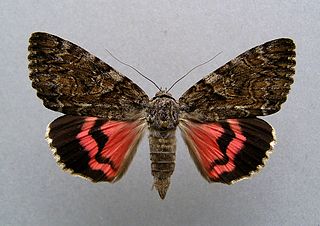
Catocala dilecta is a moth of the family Erebidae first described by Jacob Hübner in 1808. It is found in north-western Africa through southern Europe to Asia Minor.

Catocala lupina is a moth in the family Erebidae first described by Gottlieb August Wilhelm Herrich-Schäffer in 1851. It is found from south-eastern Europe to south-western Siberia, Asia Minor and Transcaucasia.

















